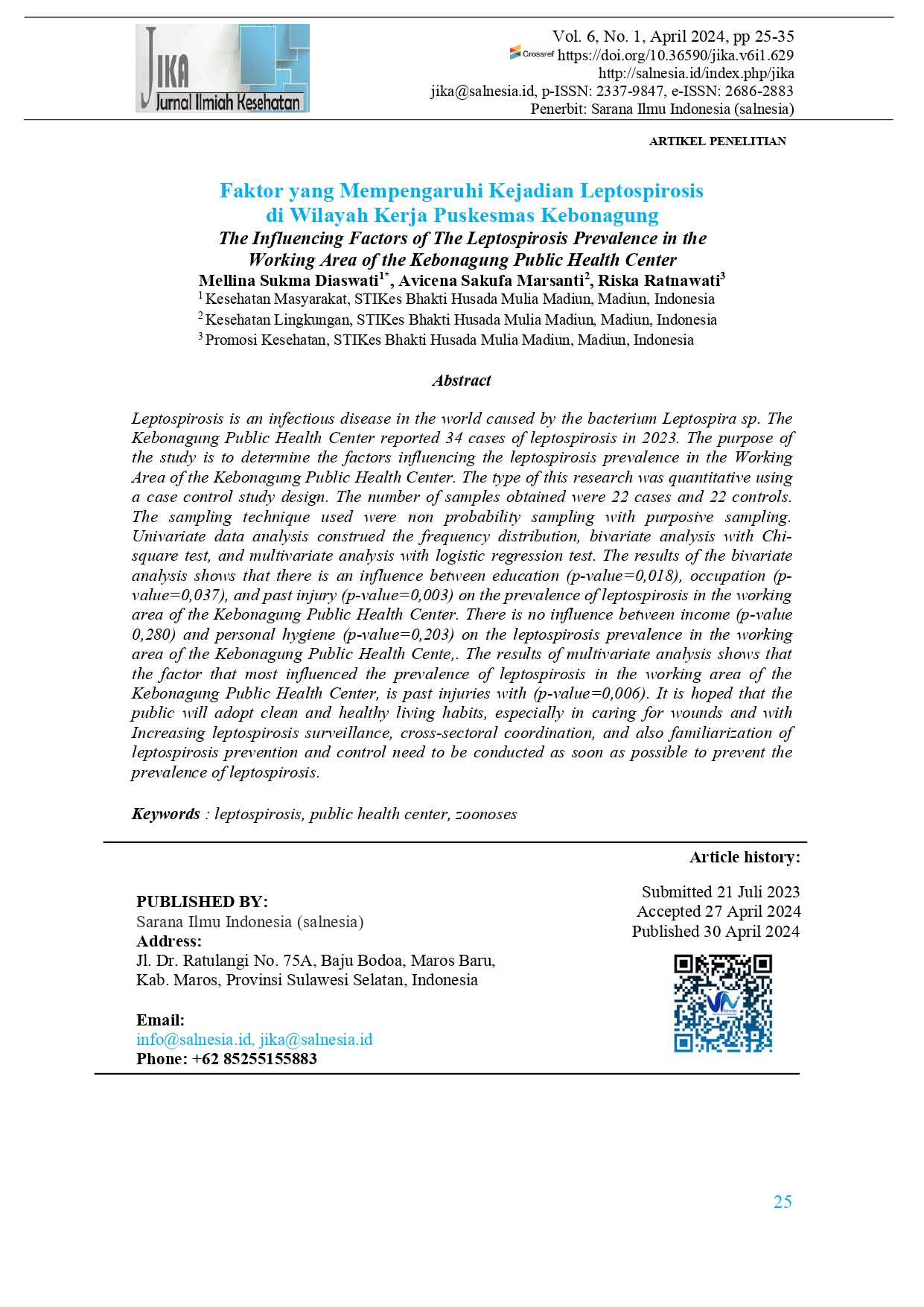The Influencing Factors of The Leptospirosis Prevalence in the Working Area of the Kebonagung Public Health Center
DOI:
https://doi.org/10.36590/jika.v6i1.629Keywords:
leptospirosis, public health center, zoonosesAbstract
Leptospirosis is an infectious disease in the world caused by the bacterium Leptospira sp. The Kebonagung Public Health Center reported 34 cases of leptospirosis in 2023. The purpose of the study is to determine the factors influencing the leptospirosis prevalence in the Working Area of the Kebonagung Public Health Center. The type of this research was quantitative using a case control study design. The number of samples obtained were 22 cases and 22 controls. The sampling technique used were non probability sampling with purposive sampling. Univariate data analysis construed the frequency distribution, bivariate analysis with Chi-square test, and multivariate analysis with logistic regression test. The results of the bivariate analysis shows that there is an influence between education (p-value=0,018), occupation (p-value=0,037), and past injury (p-value=0,003) on the prevalence of leptospirosis in the working area of the Kebonagung Public Health Center. There is no influence between income (p-value 0,280) and personal hygiene (p-value=0,203) on the leptospirosis prevalence in the working area of the Kebonagung Public Health Cente,. The results of multivariate analysis shows that the factor that most influenced the prevalence of leptospirosis in the working area of the Kebonagung Public Health Center, is past injuries with (p-value=0,006). It is hoped that the public will adopt clean and healthy living habits, especially in caring for wounds and with Increasing leptospirosis surveillance, cross-sectoral coordination, and also familiarization of leptospirosis prevention and control need to be conducted as soon as possible to prevent the prevalence of leptospirosis.
Downloads
References
Andriani R. 2019. Hubungan Faktor Lingkungan dan Perilaku Pencegahan Leptospirosis terhadap Kejadian Leptospirosis di Daerah Endemis. Higea Jurnal of Public Health Recearch and Depelopment, 4(3): 471-482. https://doi.org/10.15294/higeia.v4i3.33710.
Ariani N, Wahyono TYM. 2021. Faktor-Faktor yang Mempengaruhi Kejadian Leptospirosis di 2 Kabupaten Lokasi Surveilans Sentinel Leptospirosis Provinsi Banten Tahun 2017-2019. Jurnal Epidemiologi Kesehatan Indonesia, 4(2): 57-64. https://doi.org/10.7454/epidkes.v4i2.4063.
Budiono I. 2022. Factors Affecting the Incidence of Leptospirosis in Semarang City. Public Health Perspectives Journal, 7(1): 79-87.
Cahyati WH, Lestari F. 2019. Hubungan Kebersihan Pribadi dan Riwayat Luka dengan Kejadian Leptospirosis. Jurnal kesehatan masyarakat, 5(1): 70-79.
Dinkes [Dinas Kesehatan]. 2018. Profil Kesehatan Provinsi Jawa Timur. Surabaya: Dinas Kesehatan Provinsi Jawa Timur.
Dinkes [Dinas Kesehatan]. 2021. Profil Kesehatan Provinsi Jawa Timur. Surabaya: Dinas Kesehatan Provinsi Jawa Timur.
Dinkes [Dinas Kesehatan] Kabupaten Pacitan. 2023. Profil Kesehatan Kabupaten Pacitan 2023. Surabaya: Dinas Kesehatan Kabupaten Pacitan.
Erviana, A. 2014. Studi Epidemiologi Kejadian Leptospirosis pada Saat Banjir di kecamatan Cengkareng Periode Januari-Februari 2014. [Skripsi]. Universitas Islam Negeri Syarif Hidayatullah: Jakarta.
Fadlilah LN. 2015. Faktor yang Berhubungan dengan Praktik Pencegahan Leptospirosis di Kelurahan Randusari Kecamatan Semarang Selatan. [Skripsi]. Universitas Negeri Semarang.
Ginting B. 2022. Faktor Lingkungan, Perilaku Personal Hygiene, dan Pemakaian APD terhadap Kejadian Leptospirosis. Higeia Journal of Public Health Research and Development, 6(2): 236-250.
Harisa ER. 2022. Faktor-Faktor yang Mempengaruhi Kejadian Leptospirosis di Kota Semarang. [Tesis]. Universitas Negeri Semarang.
Kemenkes RI [Kementrian Kesehatan Republik Indonesia]. 2021. Profil Kesehatan Indonesia. Jakarta: Pusat Data dan Informasi Kementerian Kesehatan Republik Indonesia.
Kemenkes RI [Kementrian Kesehatan Republik Indonesia]. 2017. Petunjuk Teknik Pengendalian Leptospirosis. Jakarta: Kementerian Kesehatan Republik Indonesia.
Masriadi (2017) Epidemiologi Penyakit Menular. Depok: PT Raja Grafindo Persada.
Pratamawati DA, Ristiyanto, Handayani FD, Kinansi RR. 2017. Faktor Risiko Perilaku Masyarakat pada Kejadian Luar Biasa Leptospirosis Kabupaten Kebumen Tahun 2017. Jurnal Vektor dan Reservoir Penyakit, 10(2): 133-140. https://doi.org/10.22435/vk.v10i2.1069.
Ramadhani RN. 2022. Identifikasi Kondisi Lingkungan dan Keberadaan Bakteri Leptospira sp. pada Air dan Tanah di Daerah Rawan Banjir Desa Lowa Kabupaten Wajo. [Skripsi]. Universitas Hasanuddin: Makassar.
Ratnawati R. 2018. Faktor-Faktor yang Berpengaruh terhadap Kejadian Leptospirosis di Wilayah Kerja Puskesmas Ngrayun Kabupaten Ponorogo. [Skripsi]. Stikes BHM: Madiun.
Wuryandani SN. 2017. Faktor Determinan Kejadian Leptospirosis di Desa Jetak Kecamatan Tulakan Kabupaten Pacitan. [Skripsi]. Sekolah Tinggi Ilmu Kesehatan Aisyiyah: Surakarta.

Downloads
Published
How to Cite
Issue
Section
License
Copyright (c) 2024 Mellina Sukma Diaswati, Avicena Sakufa Marsanti, Riska Ratnawati

This work is licensed under a Creative Commons Attribution 4.0 International License.








